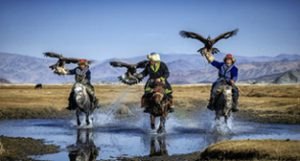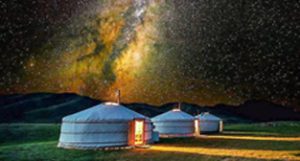General information
 Mongolia is a country located in north-central Asia. It is roughly oval in shape, measuring 2,392 km from west to east and, at its maximum, 1,259 km from north to south. Mongolia’s land area is roughly equivalent to that of the countries of western and central Europe, and it lies in a similar latitude range. The national capital, Ulaanbaatar is in the north-central part of the country. Landlocked Mongolia is located between Russia to the north and China to the south, deep within the interior of eastern Asia far from any ocean. The country has a marked continental climate, with long cold winters and short cool-to-hot summers. Its remarkable variety of scenery consists largely of upland steppes, semideserts, and deserts, although in the west and north forested high mountain ranges alternate with lake-dotted basins. Mongolia is largely a plateau, with an average elevation of about 1,580 metres above sea level. The highest peaks are in the Mongolian Altai Mountains in the southwest, a branch of the Altai Mountains system.
Mongolia is a country located in north-central Asia. It is roughly oval in shape, measuring 2,392 km from west to east and, at its maximum, 1,259 km from north to south. Mongolia’s land area is roughly equivalent to that of the countries of western and central Europe, and it lies in a similar latitude range. The national capital, Ulaanbaatar is in the north-central part of the country. Landlocked Mongolia is located between Russia to the north and China to the south, deep within the interior of eastern Asia far from any ocean. The country has a marked continental climate, with long cold winters and short cool-to-hot summers. Its remarkable variety of scenery consists largely of upland steppes, semideserts, and deserts, although in the west and north forested high mountain ranges alternate with lake-dotted basins. Mongolia is largely a plateau, with an average elevation of about 1,580 metres above sea level. The highest peaks are in the Mongolian Altai Mountains in the southwest, a branch of the Altai Mountains system.
Nomadic culture
 Mongolia is a country located in north-central Asia. It is roughly oval in shape, measuring 2,392 km from west to east and, at its maximum, 1,259 km from north to south. Mongolia’s land area is roughly equivalent to that of the countries of western and central Europe, and it lies in a similar latitude range. The national capital, Ulaanbaatar is in the north-central part of the country. Landlocked Mongolia is located between Russia to the north and China to the south, deep within the interior of eastern Asia far from any ocean. The country has a marked continental climate, with long cold winters and short cool-to-hot summers. Its remarkable variety of scenery consists largely of upland steppes, semideserts, and deserts, although in the west and north forested high mountain ranges alternate with lake-dotted basins. Mongolia is largely a plateau, with an average elevation of about 1,580 metres above sea level. The highest peaks are in the Mongolian Altai Mountains in the southwest, a branch of the Altai Mountains system.
Mongolia is a country located in north-central Asia. It is roughly oval in shape, measuring 2,392 km from west to east and, at its maximum, 1,259 km from north to south. Mongolia’s land area is roughly equivalent to that of the countries of western and central Europe, and it lies in a similar latitude range. The national capital, Ulaanbaatar is in the north-central part of the country. Landlocked Mongolia is located between Russia to the north and China to the south, deep within the interior of eastern Asia far from any ocean. The country has a marked continental climate, with long cold winters and short cool-to-hot summers. Its remarkable variety of scenery consists largely of upland steppes, semideserts, and deserts, although in the west and north forested high mountain ranges alternate with lake-dotted basins. Mongolia is largely a plateau, with an average elevation of about 1,580 metres above sea level. The highest peaks are in the Mongolian Altai Mountains in the southwest, a branch of the Altai Mountains system.
History
 Mongolia is a country located in north-central Asia. It is roughly oval in shape, measuring 2,392 km from west to east and, at its maximum, 1,259 km from north to south. Mongolia’s land area is roughly equivalent to that of the countries of western and central Europe, and it lies in a similar latitude range. The national capital, Ulaanbaatar is in the north-central part of the country. Landlocked Mongolia is located between Russia to the north and China to the south, deep within the interior of eastern Asia far from any ocean. The country has a marked continental climate, with long cold winters and short cool-to-hot summers. Its remarkable variety of scenery consists largely of upland steppes, semideserts, and deserts, although in the west and north forested high mountain ranges alternate with lake-dotted basins. Mongolia is largely a plateau, with an average elevation of about 1,580 metres above sea level. The highest peaks are in the Mongolian Altai Mountains in the southwest, a branch of the Altai Mountains system.
Mongolia is a country located in north-central Asia. It is roughly oval in shape, measuring 2,392 km from west to east and, at its maximum, 1,259 km from north to south. Mongolia’s land area is roughly equivalent to that of the countries of western and central Europe, and it lies in a similar latitude range. The national capital, Ulaanbaatar is in the north-central part of the country. Landlocked Mongolia is located between Russia to the north and China to the south, deep within the interior of eastern Asia far from any ocean. The country has a marked continental climate, with long cold winters and short cool-to-hot summers. Its remarkable variety of scenery consists largely of upland steppes, semideserts, and deserts, although in the west and north forested high mountain ranges alternate with lake-dotted basins. Mongolia is largely a plateau, with an average elevation of about 1,580 metres above sea level. The highest peaks are in the Mongolian Altai Mountains in the southwest, a branch of the Altai Mountains system.
Ethnicity
 There are 24 different ethnic groups in Mongolia. When you visit nomad families in the different parts of Mongolia, you will find that they have different customs and traditions – even the shape of the ger, how the ger is decorated, etc. varies. The most interesting ethnics among them are the Kazakh people who live in Western snow-capped Altai Mountains. They are known as the “Eagle Hunting People”. Next, are the Reindeer people who live up in the North in the forested mountains. They live in the “tepee” and their livelihood is completely dependent on nature and their few reindeer.
There are 24 different ethnic groups in Mongolia. When you visit nomad families in the different parts of Mongolia, you will find that they have different customs and traditions – even the shape of the ger, how the ger is decorated, etc. varies. The most interesting ethnics among them are the Kazakh people who live in Western snow-capped Altai Mountains. They are known as the “Eagle Hunting People”. Next, are the Reindeer people who live up in the North in the forested mountains. They live in the “tepee” and their livelihood is completely dependent on nature and their few reindeer.
Only in Mongolia
 There are many endemic wild species in Mongolia such as the Gobi/Semi desert bear and the two-humped wild camel. Besides animals, there are also rare plants. The Gobi, which is classified as a semi-desert is only in Mongolia. It is a spacious, empty, life-supporting, but surprisingly beautiful area. In reality, it’s impossible to compare the Gobi with the semi-desert.
There are many endemic wild species in Mongolia such as the Gobi/Semi desert bear and the two-humped wild camel. Besides animals, there are also rare plants. The Gobi, which is classified as a semi-desert is only in Mongolia. It is a spacious, empty, life-supporting, but surprisingly beautiful area. In reality, it’s impossible to compare the Gobi with the semi-desert.
National holidays
 One of the easiest opportunities to discover traditional aspects of Mongolian culture in one setting is to visit during the national holidays. There are two important national holidays: the Naadam Festival held in July and the Tsagaan Sar/Lunar New Year festival held in winter depending on the lunar calendar. The events and celebrations are not limited to these two holidays. You can find more about the events.
One of the easiest opportunities to discover traditional aspects of Mongolian culture in one setting is to visit during the national holidays. There are two important national holidays: the Naadam Festival held in July and the Tsagaan Sar/Lunar New Year festival held in winter depending on the lunar calendar. The events and celebrations are not limited to these two holidays. You can find more about the events.
